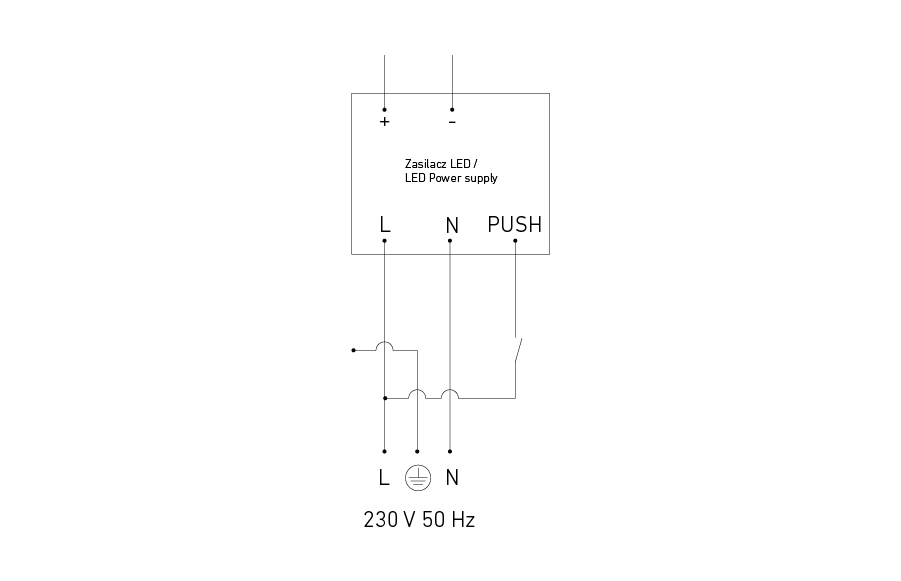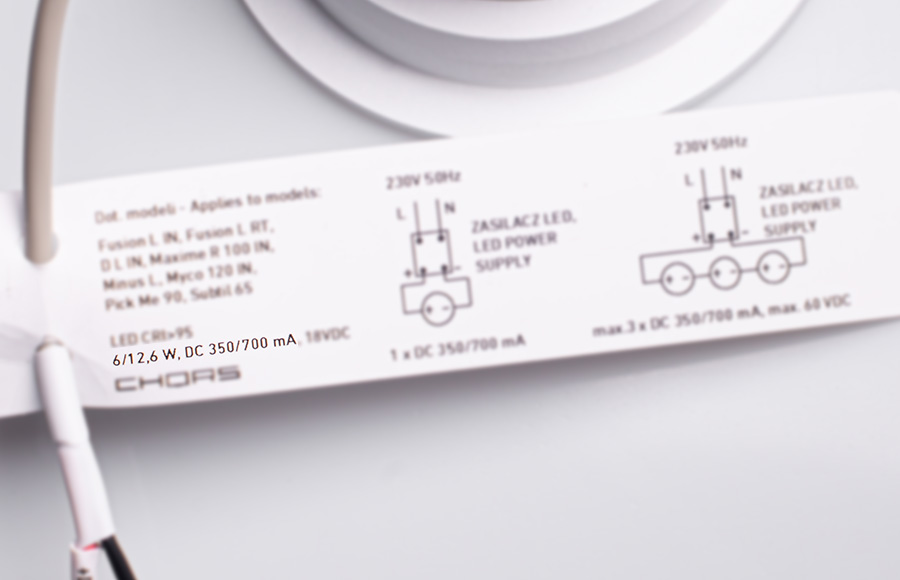Most of Chors luminaires are supplied with a built-in power supply. For some luminaires built into the ceiling, we supply luminaires without a power supply. We inform you in the table describing power supply whether the luminaire will be delivered with or without a power supply, for example 230V 50 Hz for luminaires with a power supply or for example 350 mA DC for luminaires without a power supply.
The power supplies can be switched on / off or dimmed.
Dimmable we divide due to dimming technology:

TRIAC / PHASE CUT - dimming in 100-10% analog technology. They require 3 wires for the circuit, cooperate with RC dimmers, preferably with the power adaptation function. Many dimmers are designed to dim classic incandescent bulbs (RL - LEADING EDGE, rising slope), where the power load is higher. These dimmers do not work with our fittings. Whereas RC technology (TRAILING EDGE, falling edge) is designed for electronic devices, thanks to which control problems are virtually eliminated, which are manifested, for example, by flickering luminaires or buzzing of luminaires.

DALI 2 - dimming in digital technology 100-1%. A 5-wire installation is required here - 3 wires for power supply, 2 wires for control. The system is designed to control lighting. Within one circuit, you can combine many groups of luminaires, plan dimming and use Tunable White technology, which, according to the principles of "Human Centric Lighting" allows you to adjust lighting to the daily human cycle. DALI 2 can be controlled using advanced systems that manage hundreds of grouped luminaires, and simple devices that allow you to control several luminaires grouped into individual lighting scenes. This solution finds its application in large-scale public facilities as well as smaller ones: in our homes, offices and restaurants.

Dali Push - dimming in digital technology 100-1%. A 4-wire installation is required here - 3 wires for power supply, 1 wire for control. The system is designed for simple control using a bell switch.
When choosing power supplies, we focus on meeting the following conditions:
They have a 5-year warranty and the number of on / off functions at 50,000 times (most professional versions include 100,000 times).
They are effective. That is, they do not generate much reactive power, and their efficiency is at least at the level of 85%.
They have a low flickering effect (Flickering). Flickering is a negative effect of dimmable LED luminaires. It adversely affects light reception and our mood. In more sensitive people, this can cause headache, irritability or a decrease in concentration.
How to choose the power supply in electrical terms and how to properly connect the luminaire.
We distinguish many different types of power supplies for luminaires with LEDs. For LED strips and line modules we distinguish between constant voltage VVC and current DC VDC. This distinction is due to module construction technology. In the case of constant voltage technology, voltage is stabilized and the current value changes, in the case of DC technology the voltage changes.In most of our luminaires we use current stabilization technology defined in mA. Our fittings most often have values:
For modules in Sunlike technology, CRI ≥97: 180 mA, 350 mA, 700 mA
For modules in LED CRI ≥95 technology: 350 mA, 500 mA, 700 mA.
If possible, they had a second protection class.
When choosing a power supply, remember the following rules. (For detailed information, please refer to each supplied luminaire on cables).

Rule 1. Current expressed in mA is important. The choice of a power supply with different parameters means that the luminaire shines either too weak (may also flicker) or too much, which may cause the diode to overheat.Photo cards with a diagram with information marked.

Rule 2. Diode voltage is important. For each luminaire we give the voltage value at which the diode works. Selecting too low voltage causes the luminaire not to light up, while selecting too high voltage causes the diode to burn.Photo cards with a diagram with information marked.

Rule 3. You can connect several luminaires for one power supply, but remember the two above principles and the fact that the connection of the luminaires must be serial and that the range of safe voltage for low voltage circuits is 60 VDC.